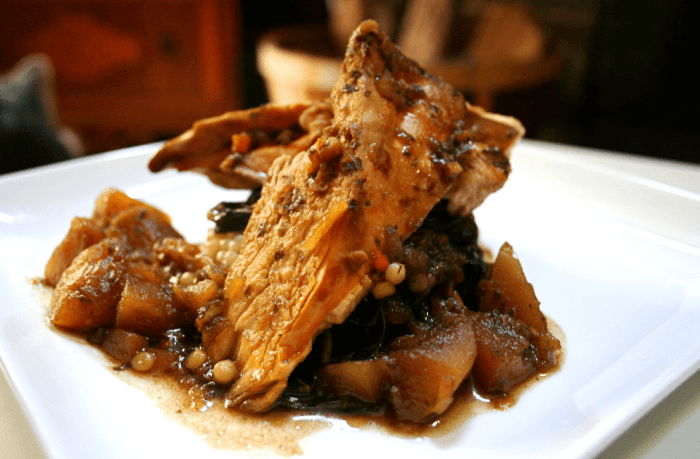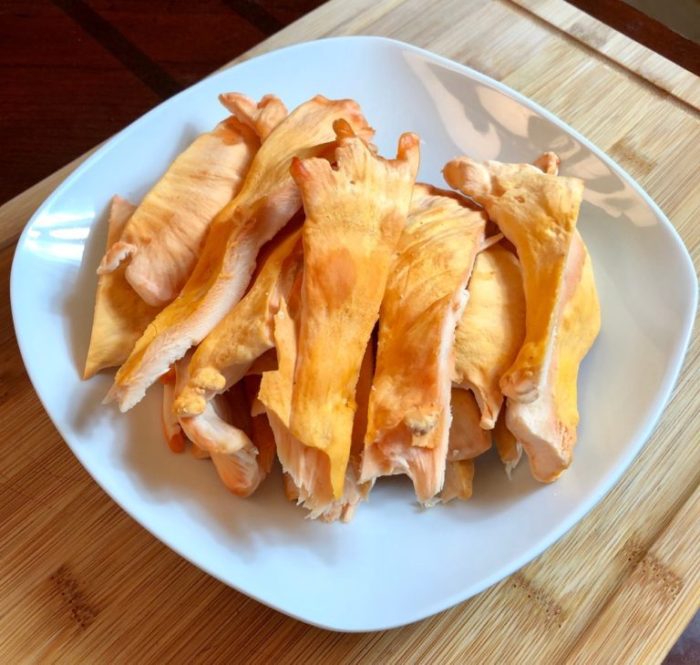
Embark on a culinary adventure with our chicken of the woods recipe guide! Discover the captivating characteristics, harvesting secrets, and delectable preparation methods of this woodland delicacy. From its vibrant colors to its earthy flavors, chicken of the woods is a mushroom that will tantalize your taste buds and inspire your culinary creativity.
As we delve into the world of chicken of the woods, we’ll explore its nutritional value, health benefits, and sustainable harvesting practices. Whether you’re a seasoned forager or a curious home cook, this guide will provide you with all the knowledge and inspiration you need to enjoy the wonders of this forest gem.
Chicken of the Woods Identification and Characteristics: Chicken Of The Woods Recipe

Chicken of the Woods is a distinctive and edible mushroom species that stands out with its unique appearance and growth patterns. Its vibrant colors and succulent texture make it a culinary delight and a sought-after ingredient among mushroom enthusiasts.
Chicken of the Woods, scientifically known as Laetiporus sulphureus, is characterized by its bright orange to yellow coloration and shelf-like growth pattern. The mushroom typically grows on dead or decaying hardwood trees, forming large, fleshy brackets that can range in size from a few inches to several feet.
Appearance and Color Variations
The appearance of Chicken of the Woods varies depending on its age and growing conditions. Young specimens tend to have a more vibrant orange color, while older ones may develop a more yellow or brownish hue. The mushroom’s surface is typically covered in small pores, which give it a slightly rough texture.
Chicken of the Woods can exhibit different color variations, including bright yellow, deep orange, and even pinkish shades. These variations are often influenced by factors such as sunlight exposure, tree species, and geographical location.
Growth Patterns
Chicken of the Woods typically grows in shelf-like or bracket-shaped formations, often overlapping and forming large clusters. The mushroom’s attachment to the tree trunk is usually through a short, thick stalk. The size of the mushroom can vary greatly, with some specimens reaching impressive dimensions.
Edibility
Chicken of the Woods is considered an edible mushroom and is prized for its meaty texture and delicate flavor. It is often described as having a chicken-like taste and texture, hence its common name. The mushroom is versatile and can be cooked in various ways, including frying, grilling, and roasting.
Importance of Proper Identification, Chicken of the woods recipe
Proper identification of Chicken of the Woods is crucial to avoid confusion with other similar-looking species. Some poisonous mushrooms, such as the Sulphur Shelf( Laetiporus sulphureus), share similar characteristics and can be mistaken for Chicken of the Woods. Therefore, it is essential to carefully observe the mushroom’s appearance, growth patterns, and habitat before consuming it.
Harvesting and Cleaning Chicken of the Woods

Chicken of the Woods is best harvested when it is young and tender, typically during the late summer and fall months. Look for mushrooms that are bright orange and have a firm, meaty texture. Avoid harvesting mushrooms that are old, slimy, or have been damaged by insects or animals.
To harvest Chicken of the Woods, carefully cut the mushroom from the base of the stem. Use a sharp knife to avoid tearing the mushroom. Once harvested, clean the mushroom by brushing off any dirt or debris. You can also use a damp cloth to wipe away any remaining dirt.
For a more detailed guide on preparing chicken of the woods, be sure to check out this chicken of the woods recipe . This article provides step-by-step instructions, along with helpful tips and tricks to ensure your dish turns out perfectly.
So gather your ingredients and get ready to cook up a storm!
It is important to handle the mushroom gently to prevent bruising or damage.
Proper Handling
Proper handling of Chicken of the Woods is crucial to maintain its freshness and prevent contamination. Store the mushrooms in a cool, dry place, such as a refrigerator. They can be stored for up to a week. If you plan on cooking the mushrooms within a few days, you can store them at room temperature.
However, it is important to keep them away from direct sunlight or heat sources.
If you’re looking for a unique and delicious vegetarian dish, check out this chicken of the woods recipe . This wild mushroom is known for its meaty texture and savory flavor, making it a great substitute for chicken in many recipes.
Whether you’re a seasoned chef or just starting out, this recipe is easy to follow and will impress your taste buds.
Before cooking, thoroughly clean the mushrooms by brushing off any remaining dirt or debris. You can also use a damp cloth to wipe away any remaining dirt. It is important to handle the mushroom gently to prevent bruising or damage.
Culinary Uses and Preparation Methods

Chicken of the Woods is a versatile culinary mushroom that can be enjoyed in a variety of ways. Its meaty texture and mild flavor make it a great substitute for chicken in many recipes.
Before cooking, it’s important to clean the mushroom thoroughly. Cut away any tough or woody stems and remove any dirt or debris. Chicken of the Woods can be cooked using a variety of methods, including sautéing, grilling, roasting, and frying.
Sautéing
- Heat a large skillet over medium heat.
- Add a drizzle of olive oil and the mushroom pieces.
- Cook for 5-7 minutes, or until the mushrooms are golden brown and tender.
- Season with salt and pepper to taste.
Grilling
- Preheat your grill to medium-high heat.
- Brush the mushroom pieces with olive oil and season with salt and pepper.
- Grill for 5-7 minutes per side, or until the mushrooms are cooked through.
- Serve immediately.
Roasting
- Preheat your oven to 400 degrees Fahrenheit.
- Toss the mushroom pieces with olive oil, salt, and pepper.
- Spread the mushrooms on a baking sheet and roast for 20-25 minutes, or until they are tender and slightly browned.
- Serve immediately.
Frying
- Heat a large skillet over medium heat.
- Add a drizzle of vegetable oil.
- Dip the mushroom pieces in flour, then egg, then breadcrumbs.
- Fry for 2-3 minutes per side, or until golden brown and crispy.
- Serve immediately.
Chicken of the Woods can also be used to make soups, stews, and sauces. Its meaty texture and mild flavor make it a great addition to any dish.
Nutritional Value and Health Benefits

Chicken of the Woods is a nutritionally rich mushroom that boasts a variety of vitamins, minerals, and antioxidants. It is a good source of dietary fiber, protein, and carbohydrates, providing essential nutrients for overall health.
Vitamin and Mineral Content
Chicken of the Woods is particularly rich in B vitamins, including niacin, riboflavin, and thiamin, which are crucial for energy production, nerve function, and overall metabolism. It also contains significant amounts of potassium, which helps regulate blood pressure and fluid balance, as well as phosphorus, which supports bone and teeth health.
Antioxidant Properties
This mushroom is a potent source of antioxidants, including ergothioneine, a unique amino acid that has been shown to protect cells from oxidative damage caused by free radicals. Additionally, it contains high levels of phenolic compounds, which have anti-inflammatory and antimicrobial properties.
Potential Health Benefits
Consuming Chicken of the Woods has been linked to several potential health benefits:
-
-*Immune System Support
If you’re looking for a delicious and unique vegetarian dish, check out this chicken of the woods recipe . This edible mushroom has a meaty texture and a slightly nutty flavor, making it a great substitute for chicken in many dishes.
It’s easy to prepare and can be used in a variety of recipes, including stir-fries, soups, and pasta dishes. So next time you’re looking for a vegetarian meal that’s both satisfying and flavorful, give this chicken of the woods recipe a try.
The high levels of antioxidants and B vitamins in Chicken of the Woods may contribute to a stronger immune system, helping to fight off infections and boost overall well-being.
-*Anti-inflammatory Properties
The phenolic compounds and ergothioneine present in this mushroom have anti-inflammatory effects, which may help reduce inflammation throughout the body and alleviate conditions such as arthritis and asthma.
-*Cholesterol Management
Some studies suggest that Chicken of the Woods may help lower cholesterol levels, potentially reducing the risk of cardiovascular disease.
Cultivation and Sustainability

Cultivating Chicken of the Woods not only provides a sustainable food source but also offers environmental benefits. With proper techniques, you can grow this mushroom at home or on a larger scale.
Growing Chicken of the Woods involves inoculating logs or sawdust with mushroom spawn. The inoculated logs are then placed in a humid environment, such as a shaded area in your backyard or a dedicated mushroom cultivation facility. Over time, the mycelium will colonize the substrate and produce fruiting bodies, or mushrooms.
Environmental Benefits
Cultivating Chicken of the Woods can contribute to ecosystem health and soil improvement. The mycelium network helps decompose organic matter, releasing nutrients back into the soil. This process enhances soil fertility and supports the growth of other plants and organisms.
Additionally, Chicken of the Woods is a natural source of food for various wildlife, including insects, birds, and small mammals. By providing a sustainable food source, cultivation can support biodiversity and maintain the balance of local ecosystems.
Sustainable Harvesting Practices
When harvesting wild Chicken of the Woods, it’s crucial to follow sustainable practices to ensure the preservation of this valuable resource. Avoid overharvesting by only taking what you need. Always leave some mushrooms behind to allow for spore dispersal and future growth.
When foraging for Chicken of the Woods, be mindful of the surrounding environment. Avoid disturbing sensitive habitats or damaging other plants and organisms. Always check local regulations and obtain necessary permits before harvesting mushrooms from public lands.
Last Recap
Our journey through the realm of chicken of the woods has illuminated its culinary versatility, ecological significance, and potential health benefits. From the moment you identify this vibrant mushroom in the wild to the moment you savor its earthy flavors on your plate, chicken of the woods offers a unique and rewarding experience.
Whether you choose to cultivate it at home or forage it responsibly in the wilderness, this woodland delicacy will continue to inspire and delight generations of mushroom enthusiasts.
Question Bank
Is chicken of the woods safe to eat?
Yes, chicken of the woods is generally considered safe to eat when properly identified and cooked. It’s important to note that some people may experience allergic reactions, so it’s recommended to consume it in moderation.
What does chicken of the woods taste like?
Chicken of the woods has a unique, meaty flavor that resembles chicken. It has a slightly sweet and earthy taste with a firm texture.
Can I grow chicken of the woods at home?
Yes, it’s possible to cultivate chicken of the woods at home. You can purchase spawn or kits online or from specialized mushroom suppliers.





